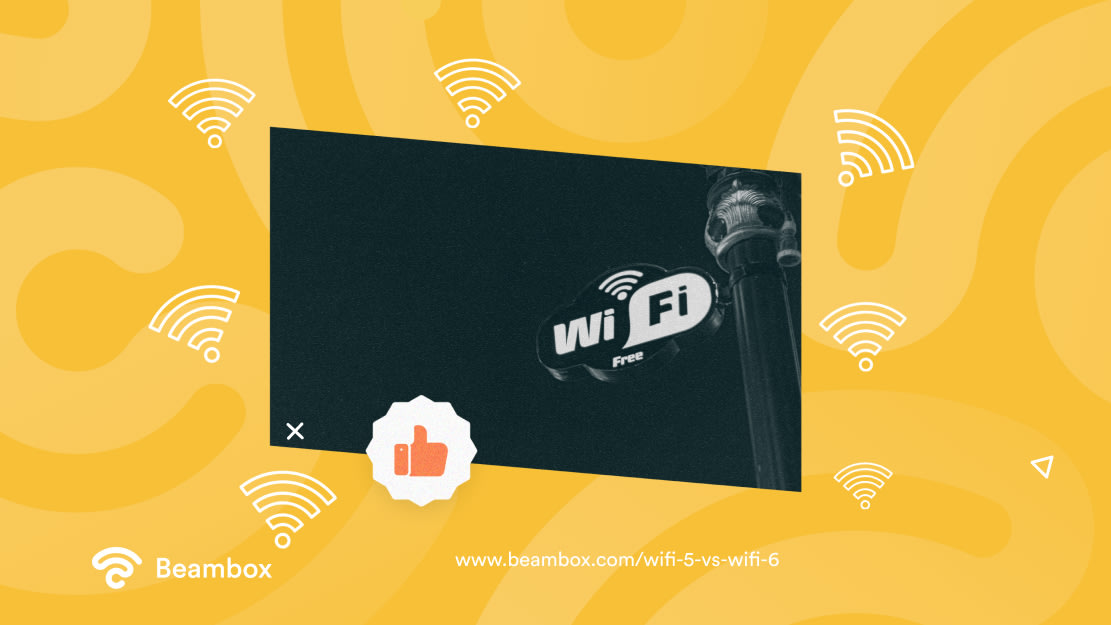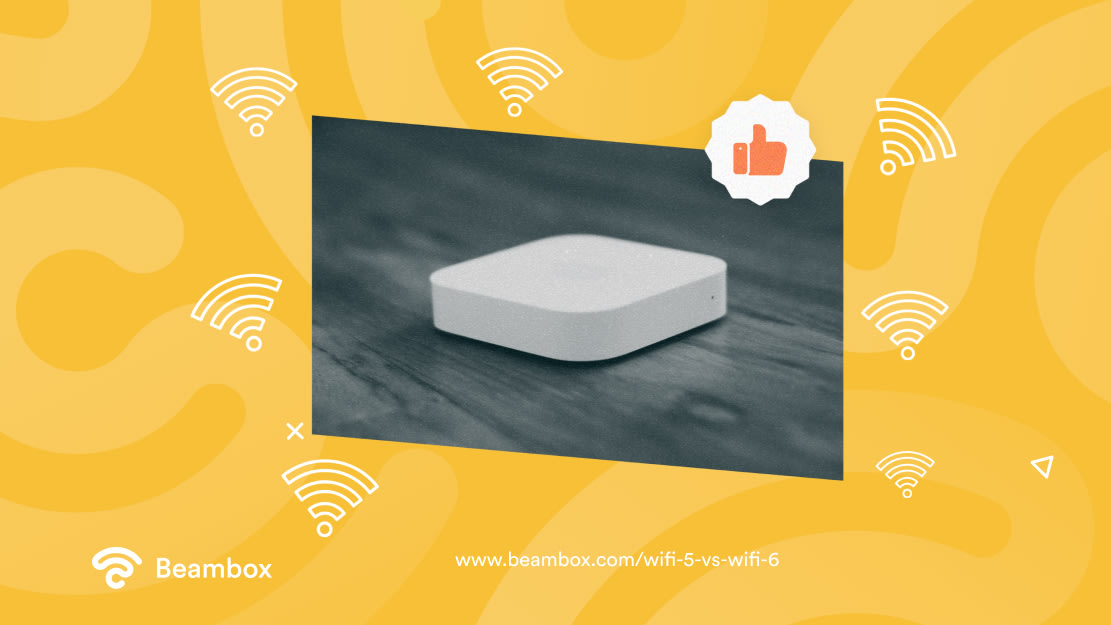WiFi 5 vs WiFi 6: What’s The Difference?
Choosing WiFi is a challenging task, especially when multiple generations are involved. Are you choosing between WiFi 5 vs WiFi 6? Well, let’s weigh it up. WiFi 5 is the older of the two generations, released in 2014, with WiFi 6 in 2019. However, that doesn’t necessarily mean you should pick WiFi 6 and call it a day.
The two generations have different pros and cons; you must understand each other to make an educated decision. For example, if you don’t rely on OFDMA technology and have low-speed demands, you probably won’t need WiFi 6.
In this guide, we’ll do the hard work for you. In just five minutes, you’ll have all the knowledge to tackle the tricky decision between the two. Get ready for in-depth comparisons, router rundowns, and an insight into what WiFi 6e is — who doesn’t love a curveball?

What Is WiFi 5 vs WiFi 6?
WiFi 5 is the fifth generation of WiFi, while WiFi 6 is the sixth generation. Once you realize they are time-related, it’s a pretty easy concept to understand.
WiFi 6 is faster and more technologically advanced but isn’t compatible with some equipment. WiFi 5 is still a great option, but it is a little more dated and has fewer advanced features.
Essentially, you are choosing between older and newer models. With 4.9 billion people using the internet worldwide, you are in good company. It’s a common debate that will continue with new WiFi generations as technology develops.
Answering the “What is WiFi 5 vs WiFi 6?” goes far beyond the surface WiFi discussions. You aren’t just deciding on 2.4 GHz vs 5 GHz, but on the generation of WiFi you’ll rely on. It’s safe to say that WiFi 6 vs WiFi 5 is a big decision.
How and When Was WiFi 6 Released?
The WiFi Alliance released WiFi 6 in late 2019. The WiFi Alliance is not a single company but a network of companies that join together to make significant industry shifts. It comprises several huge companies and strives for industry-wide collaboration globally, aiming for more connection through WiFi.
The alliance wished to release an upgraded version of WiFi 5, and they succeeded. Instead of relying on 802.11ac technology for WiFi 5, they released WiFi 6, which was compatible with 802.11ax technology.
While it may seem like a small shift in name, the number change signifies huge technological milestones and advancements. It isn’t just “When was WiFi 6 released?” but what changed when it was.
What’s the Difference Between WiFi 5 and 6?
The critical difference between WiFi 5 and 6 is that they easily have faster speeds. WiFi 6 has speeds of up to 9.6 Gbs, while WiFi 5 maxes out at 6.9 Gbs. If it’s speed you’re after, that’s the most important of the key differences between WiFi 6 vs 5 to know.
However, it goes deeper than that. Here are the top three differences you must understand when weighing up fifth and sixth-generation WiFi.
1. WiFi 6 Supports More Advanced Network Security
WiFi 5 supports WPA and WPA2 protocols, but WiFi 6 supports WPA3. What does this mean for you? Well, you’ve got more advanced security features for your internet.
There are many reasons to care about your guest network security, from reputation to customer trust and fraud prevention. It’s especially important for businesses that rely on security features to protect valuable information. WPA3 includes multi-factor authentication and has OWE technology that automatically encrypts data.
2. WiFi 6 Helps Your Devices Retain Battery Life
What’s incredible is that WiFi 6 includes a Target Wake Time feature. This monitors whether or not a device is active and, therefore, immediately reliant on WiFi. If it isn’t, it puts the connection to sleep until a need arises. WiFi drains battery life massively, so this is a handy automated trick.
How cool is having a WiFi network that optimizes your devices’ battery life? This is a big difference between the fifth and sixth generations.
3. WiFi 5 Only Uses the 5GHz Band Range
We all know the importance of your frequency band. You know how 5GHz and 2.4GHz vary and offer faster versus more powerful connections depending on your property layout. If your property isn’t ideal for 5GHz, you’ll be happy to know WiFI 6 offers both.
That difference in frequency band makes WiFi 6 more flexible in providing a reliable connection for connected devices. You can switch between 2.4GHz and 5GHz whenever you feel like it. It should definitely be a consideration when choosing between WiFi 6 and 5.

A WiFi 5 vs WiFi 6 Router: Which Is Best?
It isn’t just about choosing which generation, but a WiFi 5 vs WiFi 6 router. As you know, equipment compatibility varies depending on the WiFi generation, so it’s essential to consider routers. Below are the two main differences between WiFi 6 and 5 routers.
WiFi 6 Routers Can Still Work With WiFi 5 Devices … Ish
WiFi 6 routers still work with WiFi 5 devices, but you won’t get the high-speed results they otherwise promise. This is something to consider when going WiFi shopping for the fifth or sixth generations.
In short, the sixth-generation routers are still compatible with older devices, so upgrading will not make much difference.
WiFi 6 Routers Support 12 Streams, Not 8
A WiFi stream is the amount of data transmission pathways a router sends to and receives from devices. As you may guess, the more it sends, the faster the service.
WiFi 6 routers send 12 data streams, while WiFi 5 routers send only eight. This may not seem like a huge difference, but it is important to know that it creates a much faster experience.

The Curveball: WiFi 5 vs 6 vs 6e
Now that you’ve got all this way, it’s time for a curveball; WiFi 6 isn’t the latest technology. If you’ve not heard of WiFi 6e, here’s your introduction.
WiFi 6e is an extension of WiFi 6. Instead of only offering 2.4GHz and 5GHz frequency bands, you also get a 6GHz frequency. Of course, this means WiFi 6e is much faster than both its earlier models. So, if you want the best of the best, it’s worth looking into.
Many say it’s paving the way for a seventh generation, so it’s an excellent way to hedge your bets. You don’t want to pick WiFi 5 and lose compatibility or invest in WiFi 6 only to have to upgrade.
WiFi Alliance released this third generation in 2020, and it’s compatible with all WiFi 6 devices. Maybe set aside the WiFi 6 vs WiFi 5 debate. Instead, question whether you want WiFi 5 vs WiFi 6 vs WiFI 6e.

The Verdict: Is WiFi 6 Better Than WiFi 5?
We’d say that yes, generally speaking, it is. WiFi 6 is faster and more advanced than WiFi 5. Those faster speeds make a big difference, especially for businesses with dense user areas. Those high demands on WiFi networks can take a toll and impact guest experience. So, if you can provide better service, why not?
Of course, it isn’t just a question of “Is WiFi 6 better than WiFi 5”? What about the question of when a new generation will come out? One of the most important things to consider is how quickly you are left behind with WiFi 5 and 6. The last thing you want is to spend money and invest in a generation of WiFi that’s about to become extinct.
WiFi 7 came out in January 2024, but it’s taking its time to roll out gradually on an international scale. It’s still compatible with WiFi 5 devices, but again, not performing as effectively. WiFi 6 is slightly more compatible but with similar limitations.
Overall, we’d say that WiFi 6 is better than WiFi 5. However, it’s worth pausing any imminent decisions and holding out for WiFi 7. This way, you won’t be updating almost immediately.

Beambox: Why You Need a WiFi Strategy?
All of this WiFi talk is enough to give anyone a headache. Hopefully, you now feel crystal-clear about your approach and know you can just wait for WiFi 7’s imminent availability. Still, it’s worth reiterating why businesses even need a WiFi strategy.
WiFi marketing strategies are some of the most effective in the world. They work on a simple premise, attaching a captive portal to guest networks so you can collect valuable data.
Captive portal software is easily available through monthly subscriptions and works by temporarily blocking immediate WiFi access. Instead, a web page form pops up, and guests must input their details to proceed. The software then automatically stores all of these details, and voila — you have a useful book of marketing contacts.
WiFi keeps customers happy and provides the foundation for nearly every marketing strategy. If you want to use email or SMS marketing, you’ll need contacts, but WiFi makes that collection process passive.
At Beambox, we can make the process even easier. We pioneer an exciting all-in-one WiFi marketing software that helps streamline data collection processes. We understand the importance of ensuring your WiFi suits your business needs, offering customizable portals and advanced analytical dashboards.
Start your Beambox free trial today and embrace a far deeper strategy than WiFi 5 vs WiFi 6 alone!



